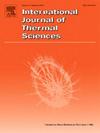Experimental flow and heat transfer analysis of electronics cooling with impinging jet and channel crossflow: The effects of nozzle geometry
IF 5
2区 工程技术
Q1 ENGINEERING, MECHANICAL
International Journal of Thermal Sciences
Pub Date : 2025-06-16
DOI:10.1016/j.ijthermalsci.2025.110075
引用次数: 0
Abstract
This study experimentally investigates the effects of crossflow interaction with jet flow emerging from jet nozzles with various geometrical forms on the heat transfer characteristics of a prismatic electronic module. Various jet nozzle exit forms, including circular, square, elliptical, and rectangular, with aspect ratios () varying between 0.33 and 3 are tested. The dimensionless jet-to-target plate distance () is maintained at 3, while the jet-to-crossflow velocity ratio () varies from 2.5 to 10 in the analysis of crossflow and jet interaction. Surface temperature contours are obtained using infrared thermography, and the resulting heat transfer coefficients are expressed in terms of local and average surface Nusselt number distributions. The dimensionless pressure loss coefficient derived from pressure readings is also reported. The findings indicate that crossflow significantly influences the temperature distribution on the module surface, particularly at low values. 47.8 % increase in the mean Nusselt number is obtained at for elliptical nozzle with 0.33 aspect ratio (EAR0.33) and rectangular nozzle with 0.33 aspect ratio (RAR0.33) compared to the circular nozzle. The rectangular nozzle forms enhance the heat transfer performance while minimizing the increase in the pressure loss coefficient, especially at higher values. The square nozzle results in a 20.3 % increase in the loss coefficient while the mean Nusselt number exhibits an enhancement of 20.1 % in returns compared to the circular one at . These values are obtained as 13.4 % and 22.5 % respectively, for RAR0.33. The findings show nozzle forms with low aspect ratios can mitigate crossflow deflection and be used effectively in crossflow environments.
冲击射流与通道横流电子冷却实验流动与传热分析:喷嘴几何形状的影响
实验研究了横流与不同几何形状射流喷嘴射流相互作用对棱镜电子模块传热特性的影响。测试了各种喷嘴出口形式,包括圆形、方形、椭圆形和矩形,宽高比(AR)在0.33到3之间变化。在横流和射流相互作用分析中,无量纲射流与靶板的距离(H/D)保持在3,射流与横流的速度比(Vr)在2.5 ~ 10之间变化。利用红外热像仪获得表面温度轮廓,所得传热系数用局部和平均表面努塞尔数分布表示。本文还报道了由压力读数导出的无量纲压力损失系数。研究结果表明,横向流动显著影响组件表面的温度分布,特别是在低Vr值时。在Vr=3时,长径比为0.33的椭圆喷管(EAR0.33)和长径比为0.33的矩形喷管(RAR0.33)的平均努塞尔数比圆形喷管增加了47.8%。矩形喷嘴形式提高了传热性能,同时使压力损失系数的增加最小化,特别是在较高的Vr值时。在Vr=10时,方形喷嘴的损失系数增加了20.3%,而平均努塞尔数比圆形喷嘴的回报增加了20.1%。对于RAR0.33,这两个值分别为13.4%和22.5%。研究结果表明,低展弦比的喷管形式可以减轻横流偏转,并在横流环境中有效使用。
本文章由计算机程序翻译,如有差异,请以英文原文为准。
求助全文
约1分钟内获得全文
求助全文
来源期刊

International Journal of Thermal Sciences
工程技术-工程:机械
CiteScore
8.10
自引率
11.10%
发文量
531
审稿时长
55 days
期刊介绍:
The International Journal of Thermal Sciences is a journal devoted to the publication of fundamental studies on the physics of transfer processes in general, with an emphasis on thermal aspects and also applied research on various processes, energy systems and the environment. Articles are published in English and French, and are subject to peer review.
The fundamental subjects considered within the scope of the journal are:
* Heat and relevant mass transfer at all scales (nano, micro and macro) and in all types of material (heterogeneous, composites, biological,...) and fluid flow
* Forced, natural or mixed convection in reactive or non-reactive media
* Single or multi–phase fluid flow with or without phase change
* Near–and far–field radiative heat transfer
* Combined modes of heat transfer in complex systems (for example, plasmas, biological, geological,...)
* Multiscale modelling
The applied research topics include:
* Heat exchangers, heat pipes, cooling processes
* Transport phenomena taking place in industrial processes (chemical, food and agricultural, metallurgical, space and aeronautical, automobile industries)
* Nano–and micro–technology for energy, space, biosystems and devices
* Heat transport analysis in advanced systems
* Impact of energy–related processes on environment, and emerging energy systems
The study of thermophysical properties of materials and fluids, thermal measurement techniques, inverse methods, and the developments of experimental methods are within the scope of the International Journal of Thermal Sciences which also covers the modelling, and numerical methods applied to thermal transfer.
 求助内容:
求助内容: 应助结果提醒方式:
应助结果提醒方式:


